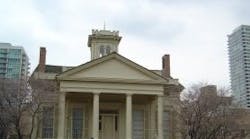Without modern utilities, how were Chicago's early mansions kept warm, cool, and lighted? Chicago's Clark house, the oldest surviving house built in 1836, had floor to ceiling windows. Open a window in the ceiling of the 3rd floor and air was pulled from the “widow's walk” on the roof through the house. Walah…air conditioning. 4 fireplaces heated the home, and mirrors set strategically through out the house reflected candle light to brighten the areas at night.
A huge 18,000 sq.ft. mansion built in 1886, the Glessner house had a fireplace in every room. The north side of the 3+ storied house had very narrow windows and a long servants' hall that acted like a buffer to keep the interior rooms warm. The half basement school room had not only a fireplace, but a 5' x 6' wall hung metal radiant heater, to keep the children warm. The large dining room boasted a curved south wall with 5 large windows to receive the sun's heat. Gas chandeliers and lamps provided light.
Which house did I prefer? The Glessner house. It had 10 servants!


